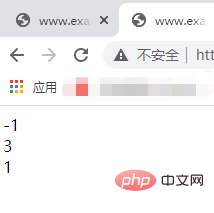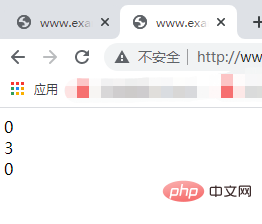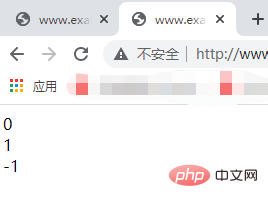How to compare strings in PHP? (detailed examples)
In the previous article "How to locate elements in strings and arrays in PHP? 》We introduced the relevant knowledge of searching and locating array elements and string elements in PHP in detail. In this article, we will take a look at the relevant knowledge of how to compare two strings in PHP. I hope it will be helpful to everyone!

In the previous article we learned that we can locate search strings and arrays through the strstr function and the preg_grep function The operation of elements is a very common operation in PHP. In this article, we will take a look at how to compare strings in PHP.
String is an important data type in PHP. How to compare strings is also very common. In our development work, there are many comparison methods for comparing strings. We will introduce them below. There are several commonly used comparison methods.
There are two functions in PHP used to compare strings. They are the strcmp() and strcasecmp() functions. Next, we will introduce them respectively. Let’s look at the usage of these two functions.
<strong><span style="font-size: 20px;">strcmp</span></strong>() function
is passed in PHP The strcmp() function can compare strings by comparing case. The basic syntax format of the strcmp() function is as follows:
strcmp(string1,string2)
What needs to be noted is that , the parameters string1 and parameter string2 are the two strings used for comparison. If the returned result is equal to 0, it means that the two strings are equal. If the returned result is greater than 0, that is Indicates that string string1 is greater than string string2. If the returned result is less than 0, it means that string string1 is less than string string2.
Let’s look at the application of strcmp() function through a simple example. The example is as follows:
<?php
echo strcmp("HELlo world!","Hello world!");
echo '<br/>';
$str1="php中文网";
$str2="php中文";
echo strcmp($str1,$str2);
echo '<br/>';
$str3="php";
$str4="PHP";
echo strcmp($str3,$str4);
?>Output result:

It should be noted that the strcmp() function is binary safe and case-sensitive.
Next let’s take a look at the use of the strcasecmp() function which is very similar to the strcmp() function.
<strong><span style="max-width:90%">strcasecmp</span></strong>() function
# in the above The ##strcmp() function is most commonly used to compare case. The function is very case-sensitive, but the strcasecmp() function is different. It is not case-sensitive. This is the only difference between them. .
strcasecmp() The basic syntax format of the function is as follows:
strcasecmp(string1,string2)
string1 and Parameter string2 is the two strings used for comparison. If the returned result is equal to 0, it means that the two strings are equal. If the returned result is greater than 0, it means that string string1 is greater than string string2. If If the returned result is less than 0, it means that string string1 is less than string string2.
<?php
echo strcasecmp("HELlo world!","Hello world!");
echo '<br/>';
$str1="php中文网";
$str2="php中文";
echo strcasecmp($str1,$str2);
echo '<br/>';
$str3="php";
$str4="PHP";
echo strcasecmp($str3,$str4);
?>
strncmp() function as supplementary knowledge.
<strong>strncmp<span style="max-width:90%"></span></strong><span style="font-size: 20px;"></span>##() functionThe
() function in PHP can be executed in the same way as the strcasecmp() function and the strcmp() function above. String comparison, what is the difference between them? After reading the syntax format of the strncmp() function, let me explain it. The basic syntax format of the strncmp() function is as follows: <div class="code" style="position:relative; padding:0px; margin:0px;"><pre class='brush:php;toolbar:false;'>strncmp(string1,string2,length)</pre><div class="contentsignin">Copy after login</div></div>It should be noted that the parameters
and string2 are the same two strings used for comparison as the two functions above. The difference is the length parameter. The length parameter indicates the number of characters used to represent each string. That is to say, by setting the length parameter, all strings are not compared.
If the returned result is equal to 0, it means that the two strings are equal. If the returned result is greater than 0, it means that string string1 is greater than string string2. If the returned result is less than 0, it means that string string1 is less than String string2.
Next let us look at the use of strncmp() function through an example. The example is as follows:
<?php $str1="php中文网"; $str2="php中文"; echo strncmp($str1,$str2,4); echo '<br/>'; $str3="php"; $str4="PHP"; echo strncmp($str3,$str4,3); echo '<br/>'; $str5="123455789"; $str6="12345678"; echo strncmp($str5,$str6,6); ?>
Output result:

From this we use the strncmp() function to compare the specified characters, which is also case-sensitive.
If you are interested, you can click on "PHP Video Tutorial" to learn more about PHP knowledge.
The above is the detailed content of How to compare strings in PHP? (detailed examples). For more information, please follow other related articles on the PHP Chinese website!

Hot AI Tools

Undresser.AI Undress
AI-powered app for creating realistic nude photos

AI Clothes Remover
Online AI tool for removing clothes from photos.

Undress AI Tool
Undress images for free

Clothoff.io
AI clothes remover

Video Face Swap
Swap faces in any video effortlessly with our completely free AI face swap tool!

Hot Article

Hot Tools

Notepad++7.3.1
Easy-to-use and free code editor

SublimeText3 Chinese version
Chinese version, very easy to use

Zend Studio 13.0.1
Powerful PHP integrated development environment

Dreamweaver CS6
Visual web development tools

SublimeText3 Mac version
God-level code editing software (SublimeText3)

Hot Topics
 1653
1653
 14
14
 1413
1413
 52
52
 1304
1304
 25
25
 1251
1251
 29
29
 1224
1224
 24
24
 PHP 8.4 Installation and Upgrade guide for Ubuntu and Debian
Dec 24, 2024 pm 04:42 PM
PHP 8.4 Installation and Upgrade guide for Ubuntu and Debian
Dec 24, 2024 pm 04:42 PM
PHP 8.4 brings several new features, security improvements, and performance improvements with healthy amounts of feature deprecations and removals. This guide explains how to install PHP 8.4 or upgrade to PHP 8.4 on Ubuntu, Debian, or their derivati
 Explain JSON Web Tokens (JWT) and their use case in PHP APIs.
Apr 05, 2025 am 12:04 AM
Explain JSON Web Tokens (JWT) and their use case in PHP APIs.
Apr 05, 2025 am 12:04 AM
JWT is an open standard based on JSON, used to securely transmit information between parties, mainly for identity authentication and information exchange. 1. JWT consists of three parts: Header, Payload and Signature. 2. The working principle of JWT includes three steps: generating JWT, verifying JWT and parsing Payload. 3. When using JWT for authentication in PHP, JWT can be generated and verified, and user role and permission information can be included in advanced usage. 4. Common errors include signature verification failure, token expiration, and payload oversized. Debugging skills include using debugging tools and logging. 5. Performance optimization and best practices include using appropriate signature algorithms, setting validity periods reasonably,
 How do you parse and process HTML/XML in PHP?
Feb 07, 2025 am 11:57 AM
How do you parse and process HTML/XML in PHP?
Feb 07, 2025 am 11:57 AM
This tutorial demonstrates how to efficiently process XML documents using PHP. XML (eXtensible Markup Language) is a versatile text-based markup language designed for both human readability and machine parsing. It's commonly used for data storage an
 Explain late static binding in PHP (static::).
Apr 03, 2025 am 12:04 AM
Explain late static binding in PHP (static::).
Apr 03, 2025 am 12:04 AM
Static binding (static::) implements late static binding (LSB) in PHP, allowing calling classes to be referenced in static contexts rather than defining classes. 1) The parsing process is performed at runtime, 2) Look up the call class in the inheritance relationship, 3) It may bring performance overhead.
 PHP Program to Count Vowels in a String
Feb 07, 2025 pm 12:12 PM
PHP Program to Count Vowels in a String
Feb 07, 2025 pm 12:12 PM
A string is a sequence of characters, including letters, numbers, and symbols. This tutorial will learn how to calculate the number of vowels in a given string in PHP using different methods. The vowels in English are a, e, i, o, u, and they can be uppercase or lowercase. What is a vowel? Vowels are alphabetic characters that represent a specific pronunciation. There are five vowels in English, including uppercase and lowercase: a, e, i, o, u Example 1 Input: String = "Tutorialspoint" Output: 6 explain The vowels in the string "Tutorialspoint" are u, o, i, a, o, i. There are 6 yuan in total
 PHP and Python: Comparing Two Popular Programming Languages
Apr 14, 2025 am 12:13 AM
PHP and Python: Comparing Two Popular Programming Languages
Apr 14, 2025 am 12:13 AM
PHP and Python each have their own advantages, and choose according to project requirements. 1.PHP is suitable for web development, especially for rapid development and maintenance of websites. 2. Python is suitable for data science, machine learning and artificial intelligence, with concise syntax and suitable for beginners.
 What are PHP magic methods (__construct, __destruct, __call, __get, __set, etc.) and provide use cases?
Apr 03, 2025 am 12:03 AM
What are PHP magic methods (__construct, __destruct, __call, __get, __set, etc.) and provide use cases?
Apr 03, 2025 am 12:03 AM
What are the magic methods of PHP? PHP's magic methods include: 1.\_\_construct, used to initialize objects; 2.\_\_destruct, used to clean up resources; 3.\_\_call, handle non-existent method calls; 4.\_\_get, implement dynamic attribute access; 5.\_\_set, implement dynamic attribute settings. These methods are automatically called in certain situations, improving code flexibility and efficiency.
 PHP: A Key Language for Web Development
Apr 13, 2025 am 12:08 AM
PHP: A Key Language for Web Development
Apr 13, 2025 am 12:08 AM
PHP is a scripting language widely used on the server side, especially suitable for web development. 1.PHP can embed HTML, process HTTP requests and responses, and supports a variety of databases. 2.PHP is used to generate dynamic web content, process form data, access databases, etc., with strong community support and open source resources. 3. PHP is an interpreted language, and the execution process includes lexical analysis, grammatical analysis, compilation and execution. 4.PHP can be combined with MySQL for advanced applications such as user registration systems. 5. When debugging PHP, you can use functions such as error_reporting() and var_dump(). 6. Optimize PHP code to use caching mechanisms, optimize database queries and use built-in functions. 7




